I'm creating a graph with values located in different columns of a data frame. Specifically from columns x=5,7,9,11 and y=6,8,10,12.
Here is a small dataset:
structure(list(number = 1:4, Start = c(2, 2, 2, 2), End = c(42,
42, 48, 48), Seq = c(0.1, 0.1, 0.1, 0.1), `50 sec` = c(0.1,
0.1, 0.1, 0.1), `t test 50 sec` = c(0.001, 0.001, 0.001, 0.001
), `200 sec` = c(1.5, 1.5, 1.5, 1.5), `t test 200 sec` = c(0.7,
0.7, 0.7, 0.7), `800 sec` = c(0.1, 1.1, 2.1, 3.1),
`t test 800 sec` = c(0.001, 0.001, 0.001, 0.001), `3200 sec` = c(0.2,
0.2, 0.2, 0.2), `t test 3200 sec` = c(0.01, 0.01, 0.01, 0.01
), `SR` = c(0, 0, 0, 0)), row.names = 3:6, class = "data.frame")
To do it I created a for loop to access those columns. however, the variable in my loops is not changing and the graph I'm getting only have the data from the first column.
Here is the code I'm using:
timepoints=4
plot=ggplot(data=newdata, aes(x=newdata[,5], y=-log10(newdata[,6])),na.rm=TRUE) + geom_point()
for (f in 2:timepoints){
plot + geom_point(aes(x=newdata[,(f*2)+3], y=-log10(newdata[,(f*2)+4])),na.rm=TRUE)
}
I tried introducing a local variable, but didn't work either.
timepoints=4
local({
f=f
plot=ggplot(data=newdata, aes(x=newdata[,5], y=-log10(newdata[,6])),na.rm=TRUE) + geom_point()
for (f in 2:timepoints){
plot + geom_point(aes(x=newdata[,(f*2)+3], y=-log10(newdata[,(f*2)+4])),na.rm=TRUE)
}})

